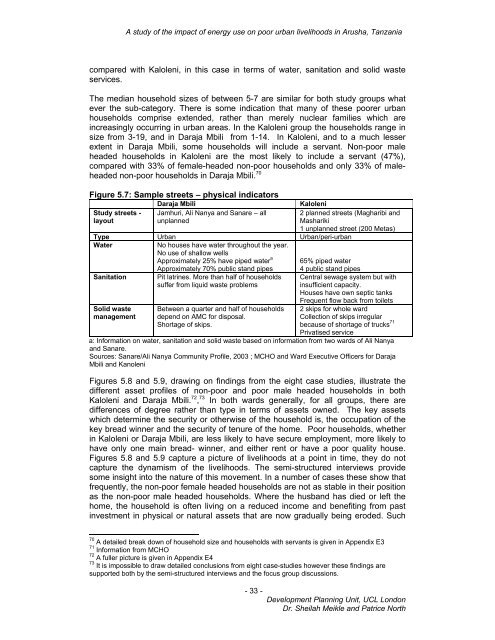The Impact of Energy Use on Poor Urban Livelihoods in ... - DfID
The Impact of Energy Use on Poor Urban Livelihoods in ... - DfID
The Impact of Energy Use on Poor Urban Livelihoods in ... - DfID
Create successful ePaper yourself
Turn your PDF publications into a flip-book with our unique Google optimized e-Paper software.
A study <str<strong>on</strong>g>of</str<strong>on</strong>g> the impact <str<strong>on</strong>g>of</str<strong>on</strong>g> energy use <strong>on</strong> poor urban livelihoods <strong>in</strong> Arusha, Tanzania<br />
compared with Kaloleni, <strong>in</strong> this case <strong>in</strong> terms <str<strong>on</strong>g>of</str<strong>on</strong>g> water, sanitati<strong>on</strong> and solid waste<br />
services.<br />
<str<strong>on</strong>g>The</str<strong>on</strong>g> median household sizes <str<strong>on</strong>g>of</str<strong>on</strong>g> between 5-7 are similar for both study groups what<br />
ever the sub-category. <str<strong>on</strong>g>The</str<strong>on</strong>g>re is some <strong>in</strong>dicati<strong>on</strong> that many <str<strong>on</strong>g>of</str<strong>on</strong>g> these poorer urban<br />
households comprise extended, rather than merely nuclear families which are<br />
<strong>in</strong>creas<strong>in</strong>gly occurr<strong>in</strong>g <strong>in</strong> urban areas. In the Kaloleni group the households range <strong>in</strong><br />
size from 3-19, and <strong>in</strong> Daraja Mbili from 1-14. In Kaloleni, and to a much lesser<br />
extent <strong>in</strong> Daraja Mbili, some households will <strong>in</strong>clude a servant. N<strong>on</strong>-poor male<br />
headed households <strong>in</strong> Kaloleni are the most likely to <strong>in</strong>clude a servant (47%),<br />
compared with 33% <str<strong>on</strong>g>of</str<strong>on</strong>g> female-headed n<strong>on</strong>-poor households and <strong>on</strong>ly 33% <str<strong>on</strong>g>of</str<strong>on</strong>g> maleheaded<br />
n<strong>on</strong>-poor households <strong>in</strong> Daraja Mbili. 70<br />
Figure 5.7: Sample streets – physical <strong>in</strong>dicators<br />
Daraja Mbili Kaloleni<br />
Study streets - Jamhuri, Ali Nanya and Sanare – all 2 planned streets (Magharibi and<br />
layout<br />
unplanned<br />
Mashariki<br />
1 unplanned street (200 Metas)<br />
Type <strong>Urban</strong> <strong>Urban</strong>/peri-urban<br />
Water No houses have water throughout the year.<br />
No use <str<strong>on</strong>g>of</str<strong>on</strong>g> shallow wells<br />
Approximately 25% have piped water a<br />
65% piped water<br />
Approximately 70% public stand pipes 4 public stand pipes<br />
Sanitati<strong>on</strong> Pit latr<strong>in</strong>es. More than half <str<strong>on</strong>g>of</str<strong>on</strong>g> households Central sewage system but with<br />
suffer from liquid waste problems<br />
<strong>in</strong>sufficient capacity.<br />
Houses have own septic tanks<br />
Frequent flow back from toilets<br />
Solid waste Between a quarter and half <str<strong>on</strong>g>of</str<strong>on</strong>g> households 2 skips for whole ward<br />
management depend <strong>on</strong> AMC for disposal.<br />
Shortage <str<strong>on</strong>g>of</str<strong>on</strong>g> skips.<br />
Collecti<strong>on</strong> <str<strong>on</strong>g>of</str<strong>on</strong>g> skips irregular<br />
because <str<strong>on</strong>g>of</str<strong>on</strong>g> shortage <str<strong>on</strong>g>of</str<strong>on</strong>g> trucks 71<br />
Privatised service<br />
a: Informati<strong>on</strong> <strong>on</strong> water, sanitati<strong>on</strong> and solid waste based <strong>on</strong> <strong>in</strong>formati<strong>on</strong> from two wards <str<strong>on</strong>g>of</str<strong>on</strong>g> Ali Nanya<br />
and Sanare.<br />
Sources: Sanare/Ali Nanya Community Pr<str<strong>on</strong>g>of</str<strong>on</strong>g>ile, 2003 ; MCHO and Ward Executive Officers for Daraja<br />
Mbili and Kanoleni<br />
Figures 5.8 and 5.9, draw<strong>in</strong>g <strong>on</strong> f<strong>in</strong>d<strong>in</strong>gs from the eight case studies, illustrate the<br />
different asset pr<str<strong>on</strong>g>of</str<strong>on</strong>g>iles <str<strong>on</strong>g>of</str<strong>on</strong>g> n<strong>on</strong>-poor and poor male headed households <strong>in</strong> both<br />
Kaloleni and Daraja Mbili. 72 , 73 In both wards generally, for all groups, there are<br />
differences <str<strong>on</strong>g>of</str<strong>on</strong>g> degree rather than type <strong>in</strong> terms <str<strong>on</strong>g>of</str<strong>on</strong>g> assets owned. <str<strong>on</strong>g>The</str<strong>on</strong>g> key assets<br />
which determ<strong>in</strong>e the security or otherwise <str<strong>on</strong>g>of</str<strong>on</strong>g> the household is, the occupati<strong>on</strong> <str<strong>on</strong>g>of</str<strong>on</strong>g> the<br />
key bread w<strong>in</strong>ner and the security <str<strong>on</strong>g>of</str<strong>on</strong>g> tenure <str<strong>on</strong>g>of</str<strong>on</strong>g> the home. <strong>Poor</strong> households, whether<br />
<strong>in</strong> Kaloleni or Daraja Mbili, are less likely to have secure employment, more likely to<br />
have <strong>on</strong>ly <strong>on</strong>e ma<strong>in</strong> bread- w<strong>in</strong>ner, and either rent or have a poor quality house.<br />
Figures 5.8 and 5.9 capture a picture <str<strong>on</strong>g>of</str<strong>on</strong>g> livelihoods at a po<strong>in</strong>t <strong>in</strong> time, they do not<br />
capture the dynamism <str<strong>on</strong>g>of</str<strong>on</strong>g> the livelihoods. <str<strong>on</strong>g>The</str<strong>on</strong>g> semi-structured <strong>in</strong>terviews provide<br />
some <strong>in</strong>sight <strong>in</strong>to the nature <str<strong>on</strong>g>of</str<strong>on</strong>g> this movement. In a number <str<strong>on</strong>g>of</str<strong>on</strong>g> cases these show that<br />
frequently, the n<strong>on</strong>-poor female headed households are not as stable <strong>in</strong> their positi<strong>on</strong><br />
as the n<strong>on</strong>-poor male headed households. Where the husband has died or left the<br />
home, the household is <str<strong>on</strong>g>of</str<strong>on</strong>g>ten liv<strong>in</strong>g <strong>on</strong> a reduced <strong>in</strong>come and benefit<strong>in</strong>g from past<br />
<strong>in</strong>vestment <strong>in</strong> physical or natural assets that are now gradually be<strong>in</strong>g eroded. Such<br />
70<br />
A detailed break down <str<strong>on</strong>g>of</str<strong>on</strong>g> household size and households with servants is given <strong>in</strong> Appendix E3<br />
71<br />
Informati<strong>on</strong> from MCHO<br />
72<br />
A fuller picture is given <strong>in</strong> Appendix E4<br />
73<br />
It is impossible to draw detailed c<strong>on</strong>clusi<strong>on</strong>s from eight case-studies however these f<strong>in</strong>d<strong>in</strong>gs are<br />
supported both by the semi-structured <strong>in</strong>terviews and the focus group discussi<strong>on</strong>s.<br />
- 33 -<br />
Development Plann<strong>in</strong>g Unit, UCL L<strong>on</strong>d<strong>on</strong><br />
Dr. Sheilah Meikle and Patrice North
















